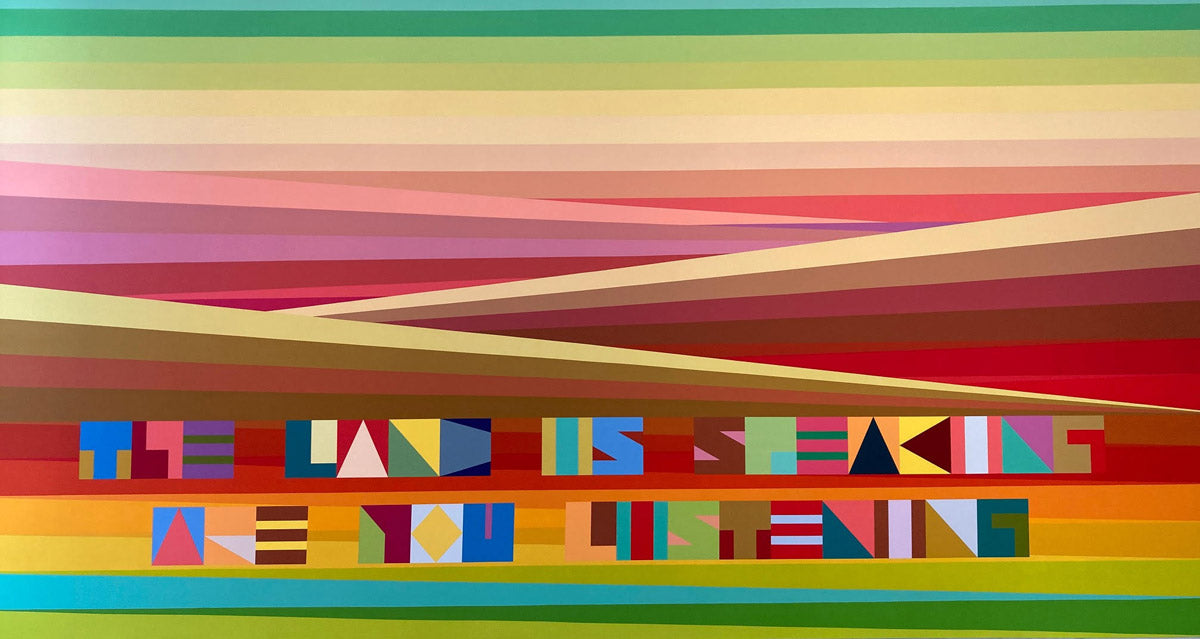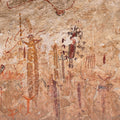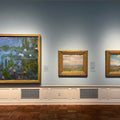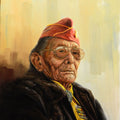Contemporary Native American artists Nani Chacon and Jeffrey Gibson in spotlight at SITE Santa Fe
By Medicine Man Gallery on
Nani Chacon (Diné), Asdzáá Na’ashjé íí (2022). Acrylic on Polytab; installation at SITE Santa Fe | Photo: Chadd Scott
“Indigenous Celebration New Mexico 2022” signifies a year’s long coming together of the state’s cultural institutions – Indigenous and otherwise – recognizing and promoting a historic confluence of significant anniversaries occurring across the Native American arts community around the state. The commemoration seeks to establish New Mexico internationally as the world’s most notable destination to experience Native American culture and the most recognized location to learn about, view and purchase Indigenous Art.
At SITE Santa Fe, a cutting-edge exhibition space for contemporary art opened in 1995, it’s presentations this summer highlighting a pair of contemporary Native American artists wasn’t planned to coincide with IC22. Consider it a happy accident, to use a famous art phrase.
In displaying the work of Nani Chacon (b. 1980; Diné) and Jeffrey Gibson (b. 1972; Mississippi Band of Choctaw and Cherokee), SITE Santa Fe simply aspired to showcase the most relevant, high-quality, contemporary artwork it could lay its hands on. The shared Indigenous backgrounds of the artists was coincidence. A meaningful coincidence evidencing an ongoing break down of the wall traditionally isolating contemporary Native American art from Contemporary Art – big picture.
“Nani and Jeffrey are contemporary artists of our time,” SITE Santa Fe Curator Brandee Caoba said, forwarding the pair’s broader engagement with concerns facing present-day society in their artwork ahead of their happening to be Native American. “They're both addressing complex intersections of gender and race and balances between individualism and community; all of these are contemporary conversations of our time.”
The same conversations visitors would find being explored at any contemporary art space across the country. How Chacon and Gibson are choosing to tackle these issues, however, does come from a perspective particularly informed by their Indigenous heritage. In that way, the artists and the shows complement each other.
“Both of them are pushing forward really interesting ideas; they're both simultaneously acknowledging Indigenous knowledge systems, recognizing that art’s a powerful tool of resistance and protection and preservation,” Caoba said. “I think there's a level of cultural preservation that is occurring in both of their practices.”
“Indigenous knowledge system” is a phrase being used more and more regularly throughout the arts, but within the wider world as well. For instance, in the effort to combat climate change, governments, non-profits and individuals are increasingly seeking the advice of Indigenous people for solutions to land and water use based on lessons learned over millennia of living more harmoniously with nature.
“Indigenous knowledge systems are rooted in kinship with the natural world, our relationship to each other,” Caoba explains. “Acknowledging plants, trees, animals (and) natural elements that make up the planet as a whole – as our relatives – and understanding our relationships to each other, not as the ‘other,’ but as the whole.”
Nani Chacon, (Diné), Emersion to the Blue World, (2017). Acrylic on Polytab; installation view at SITE Santa Fe | Photo: Chadd Scott
Nani Chacon
Anyone moving around New Mexico has likely come across the work of Nani Chacon if they know where to look and what to look for. The born and raised New Mexican has 19 murals across the state with one completed late in 2021 outside the Coe Center not far from SITE Santa Fe.
Chacon’s murals are enormous and created in collaboration with the communities where they reside.
“When I invited her to SITE Santa Fe, (I wondered) how am I going to show this artist’s work within the context of a museum because it's community art that's accessible and for everybody,” Caoba said. “That's definitely something that she holds true as a very strong philosophy about her work, that art is for everyone, and that it should be public, it should be education, it should be outreach.”
SITE Santa Fe’s free admission policy keeps Chacon’s artwork on view there public. Fascinating preliminary sketches – including her handwritten mathematical figuring notes – along with photographs of completed mural projects from around the state and world bring her outdoor work indoors.
SITE’s presentation of Chacon shines brightest through eight large scale figurative paintings based on Diné creation mythology, all painted within the last year, all ideas she's long been interested in and researching. This is the artist expressing her personal thoughts, focusing on what she wants to express through her own voice, not through the collaborative voice of community-centered projects.
“Nani Chacon: SPECTRUM” is on view through August 21, 2022.
Jeffrey Gibson (Mississippi Band Choctaw and Cherokee), The Land is Speaking, Are You Listening, (2022). Mural at SITE Santa Fe.| Photo: Chadd Scott
Jeffrey Gibson
Perhaps more than any other Native American artist working today, Jeffrey Gibson has fully crossed over into the wider Contemporary Art world. His work is being exhibited and increasingly displayed in art museums across the country – and beyond.
He collaborated with Sarah Ortegon (Eastern Shoshone and Northern Arapaho), an acclaimed jingle dress dancer and Miss Native American USA 2013–14, for a multi-channel video created specifically for the screens of New York’s Times Square, She Never Dances Alone (2019). The video appeared as the Midnight Moment from March through July 2020, at the height of the COVID-19 pandemic, playing each night to the world from Times Square between 11:57 pm and midnight, a vibrant, hopeful message of resilience and beauty in a world gasping for both.
https://www.youtube.com/watch?v=o24ulQLly3M
“Jeffrey's reclaiming dance and art as a powerful tool of resistance and protection,” Caoba explains. “While Sarah is dancing alone in the video, it’s (portraying the) concept of empowerment and resistance and using dance as a form of resistance.”
Caoba goes on to note that the Indigenous water protectors opposing the Dakota Access Pipeline on the Standing Rock Sioux Reservation, an effort led by women, incorporated traditional dance in the face of heavily armed and militarized police and private security mercenaries to protest the oil pipeline’s incursion into tribal drinking water supplies.
“It’s very powerful how these things that we see as entertainment (are used) as a tool,” she said.
As part of its vivid, expansive, fantastical presentation of Gibson’s work, SITE Santa Fe has invited Ortegon to dance on location during Indian Market weekend.
Jeffrey Gibson’s “The Body Electric” will be on view from May 6 through September 11, 2022.






